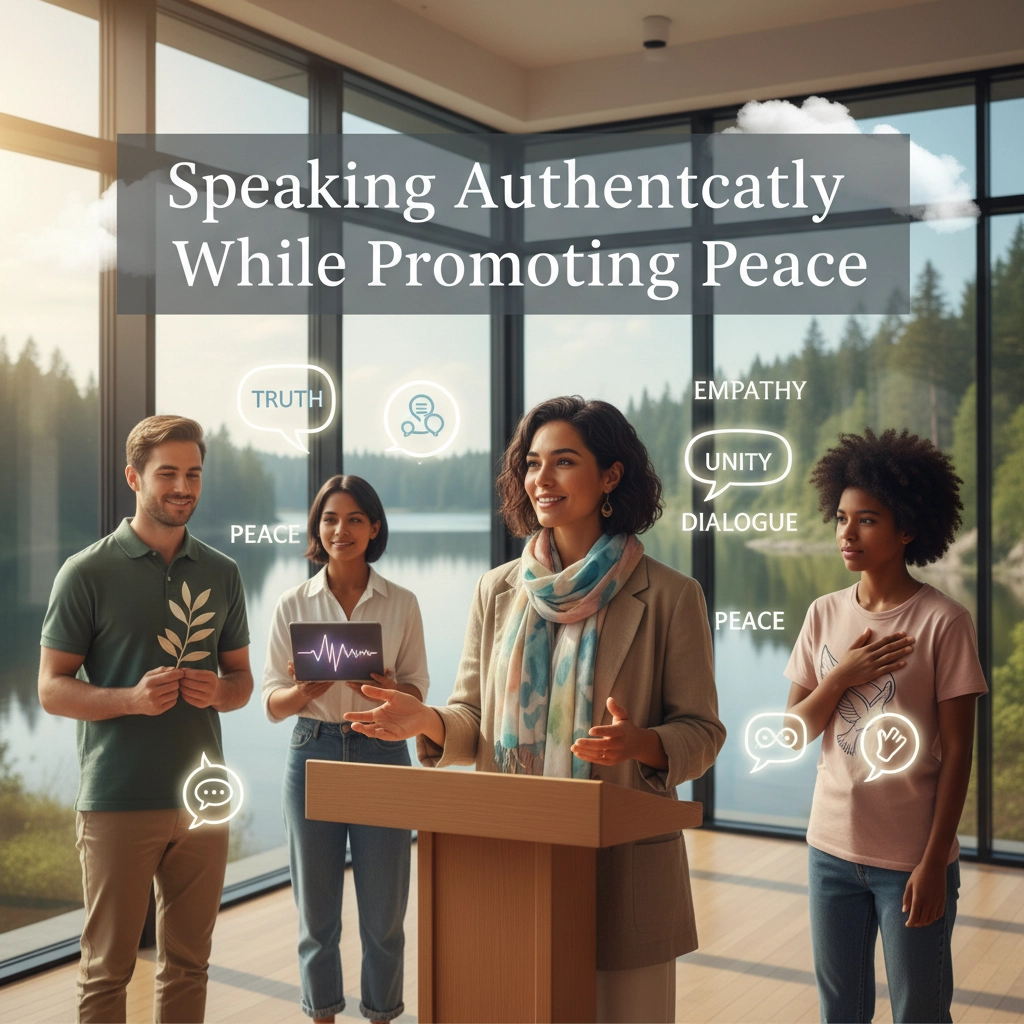In today's polarized world, the ability to speak authentically while promoting peace isn't just a nice-to-have skill: it's essential for anyone in leadership, coaching, or training roles. Whether you're facilitating a tense team meeting, coaching someone through a difficult situation, or speaking to a diverse audience, the challenge is real: How do you stay true to yourself while actively fostering understanding and harmony?
The answer lies in mastering a delicate balance between honest self-expression and intentional peace-building. This isn't about avoiding tough conversations or sugarcoating difficult truths. Instead, it's about developing the skills to communicate with both courage and compassion.
Why Authenticity and Peace Aren't Opposites
Many people assume that speaking authentically means "telling it like it is" regardless of the consequences, while promoting peace means avoiding conflict at all costs. This false dichotomy has created countless problems in workplaces, communities, and relationships.
The truth is more nuanced. Authentic peace communication involves expressing your genuine thoughts, feelings, and concerns in ways that invite connection rather than defensiveness. It's about being honest without being harmful, direct without being destructive.

When you speak authentically with peaceful intent, you're not compromising your values or hiding your truth. You're choosing to express that truth in ways that create bridges rather than walls. This approach actually requires more courage than either pure confrontation or complete avoidance because it demands both self-awareness and emotional intelligence.
The Foundation: Understanding Before Being Understood
The most powerful authentic speakers who promote peace share one common trait: they prioritize understanding others before seeking to be understood themselves. This doesn't mean abandoning your position or suppressing your voice. It means approaching conversations with genuine curiosity about others' perspectives.
Active listening becomes your most important tool here. When you truly listen: not just waiting for your turn to speak: you demonstrate respect for the other person's experience. This creates psychological safety that makes authentic dialogue possible.
Pay attention to both verbal and nonverbal cues. Sometimes what people aren't saying is more important than what they are saying. A defensive posture, crossed arms, or avoiding eye contact can signal that someone feels unheard or threatened, even if their words suggest otherwise.
Speaking Your Truth Without Triggering Defensiveness
One of the biggest challenges in authentic peace communication is expressing disagreement or difficult truths without causing others to shut down or become defensive. The key lies in how you frame your observations and concerns.
Instead of making evaluative statements that sound like judgments, focus on specific, observable behaviors and their impact. For example, rather than saying "You're being disrespectful," try "When I hear interruptions during my presentations, I feel like my ideas aren't being valued, and it makes it harder for me to share effectively."

This approach accomplishes several things simultaneously. You're being completely honest about your experience and its impact on you. You're avoiding blame or character attacks that would trigger defensiveness. And you're creating an opening for dialogue about how to move forward together.
Navigating Cultural and Personal Differences
Speaking authentically while promoting peace becomes more complex when you're working across cultural, generational, or ideological differences. What feels authentic and respectful in one context might be perceived differently in another.
This is where cultural humility becomes essential. Acknowledge that your perspective is shaped by your own experiences and that others may see things differently for equally valid reasons. This doesn't mean abandoning your convictions, but it does mean holding them with enough flexibility to engage meaningfully with diverse viewpoints.
When facilitating discussions among diverse groups, explicitly acknowledge these differences upfront. Create space for people to share how they prefer to communicate and what makes them feel respected. This proactive approach prevents many misunderstandings before they occur.
Practical Techniques for Daily Application
The Pause Principle: Before responding to challenging statements or situations, take a conscious pause. Use this moment to check in with yourself: What am I feeling right now? What do I really want to accomplish with my response? How can I express this in a way that serves everyone involved?
The Bridge Language: Use phrases that connect rather than divide. Instead of "But…" which negates what came before, try "And…" which builds on it. Instead of "You're wrong about…" try "I see it differently because…" These small linguistic choices can dramatically shift the tone of a conversation.

The Validation First Rule: Before expressing disagreement or offering corrections, acknowledge what you can genuinely appreciate or understand about the other person's perspective. This isn't manipulation: it's recognizing the complexity of most situations and demonstrating respect for the person even when you disagree with their position.
Common Pitfalls and How to Avoid Them
The Authenticity Trap: Some people use "authenticity" as an excuse for poor communication choices. Saying "I'm just being honest" doesn't justify being unnecessarily harsh or insensitive. True authenticity includes being authentic about your desire to maintain relationships and find solutions together.
The Peace-at-Any-Cost Mistake: On the flip side, some people suppress important concerns in the name of keeping peace. This creates false harmony that inevitably breaks down over time. Real peace requires addressing underlying issues, not avoiding them.
The Perfectionism Paralysis: Waiting until you can communicate perfectly before addressing important issues often means waiting too long. Accept that you'll make mistakes and focus on repair when they happen. A sincere "I don't think I expressed that well: let me try again" can be incredibly powerful.
Building These Skills Over Time
Like any complex skill set, speaking authentically while promoting peace requires ongoing development. Start by practicing in lower-stakes situations. Notice your communication patterns during everyday interactions. Do you tend to avoid conflict or dive into it headfirst? Both extremes limit your effectiveness.

Seek feedback from trusted colleagues or friends about your communication style. Ask specifically about times when you've managed to be both honest and diplomatic. What did you do well? What could you improve? This external perspective can help you identify blind spots and build on your strengths.
Consider the long-term impact of your communication choices. The goal isn't just to get through difficult conversations: it's to strengthen relationships and build trust over time. Every interaction is an opportunity to demonstrate that you can be trusted with both honesty and care.
The Ripple Effect
When you master authentic peace communication, you don't just improve your own relationships and effectiveness: you model a different way of engaging for everyone around you. In team settings, workplaces, and communities, people often mirror the communication styles they experience.
By consistently demonstrating that it's possible to be both genuine and constructive, you give others permission to do the same. This creates a positive feedback loop that can transform entire organizational cultures or community dynamics.
The world needs more people who can speak their truth with courage and compassion. Whether you're coaching individuals, training teams, or simply navigating your daily interactions, developing these skills serves not just your own success but contributes to a more understanding and peaceful world.
Remember: authentic peace communication isn't about perfection: it's about intention. When you commit to expressing yourself honestly while actively seeking understanding and connection with others, you're already making a difference that extends far beyond any single conversation.
